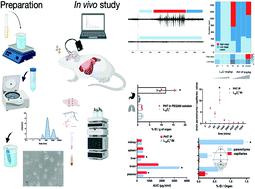当前位置:
X-MOL 学术
›
Biomater. Sci.
›
论文详情
Our official English website, www.x-mol.net, welcomes your feedback! (Note: you will need to create a separate account there.)
Intranasal delivery of phenytoin-loaded nanoparticles to the brain suppresses pentylenetetrazol-induced generalized tonic clonic seizures in an epilepsy mouse model
Biomaterials Science ( IF 6.6 ) Pub Date : 2021-09-30 , DOI: 10.1039/d1bm01251g Amal Yousfan 1 , Noelia Rubio 2 , Mohammad Al-Ali 3 , Abdul Hakim Nattouf 1 , Houmam Kafa 3
Biomaterials Science ( IF 6.6 ) Pub Date : 2021-09-30 , DOI: 10.1039/d1bm01251g Amal Yousfan 1 , Noelia Rubio 2 , Mohammad Al-Ali 3 , Abdul Hakim Nattouf 1 , Houmam Kafa 3
Affiliation

|
In this work we describe the preparation and characterization of lecithin–chitosan nanoparticles (L10Ci+), and investigate their ability to deliver the anti-epileptic drug phenytoin (PHT) to mouse brain following intranasal (IN) administration. L10Ci+ were retained in the nasal cavity compared to PHT in PEG200 solution (PHT/PEG), which suffered immediate nasal drainage. PHT was detected in the brain after 5 min of IN administration reaching a maximum of 11.84 ± 2.31 %ID g−1 after 48 hours. L10Ci+ were associated with a higher brain/plasma ratio (Cb/p) compared to the experimental control comprising free PHT injected via the intraperitoneal route (PHT-IP) across all tested time points. Additionally, L10Ci+ led to lower PHT accumulation in the liver and spleen compared to PHT-IP, which is vital for lowering the systemic side effects of PHT. The relatively high drug targeting efficiency (DTE%) of 315.46% and the drug targeting percentage (DTP%) of 68.29%, combined with the increasing anterior-to-posterior gradient of PHT in the brain confirmed the direct nose-to-brain transport of PHT from L10Ci+. Electroencephalogram (EEG) analysis was used to monitor seizure progression. L10Ci+ resulted in a complete seizure suppression after 4 hours of administration, and this inhibition persisted even with an 8-fold reduction of the encapsulated dose compared to the required PHT-IP dose to achieve a similar inhibitory effect due to systemic loss. The presented findings confirm the possibility of using L10Ci+ as a non-invasive delivery system of PHT for the management of epilepsy using reduced doses of PHT.
中文翻译:

将载有苯妥英的纳米颗粒鼻内递送至大脑可抑制癫痫小鼠模型中戊四唑诱导的全身性强直阵挛发作
在这项工作中,我们描述了卵磷脂-壳聚糖纳米颗粒 (L 10 C i + )的制备和表征,并研究了它们在鼻内 (IN) 给药后将抗癫痫药物苯妥英 (PHT) 递送至小鼠大脑的能力。与 PEG200 溶液 (PHT/PEG) 中的 PHT 相比,L 10 C i +保留在鼻腔中,后者遭受立即鼻腔引流。在给予 IN 5 分钟后,在大脑中检测到 PHT ,48 小时后达到 11.84 ± 2.31 %ID g -1的最大值。L 10 C i +与较高的脑/血浆比率(C b/p) 与包含在所有测试时间点通过腹膜内途径 (PHT-IP)注射的游离 PHT 的实验对照相比。此外,与 PHT-IP 相比,L 10 C i +可降低肝脏和脾脏中的 PHT 积累,这对于降低 PHT 的全身副作用至关重要。315.46% 的相对较高的药物靶向效率(DTE%)和 68.29% 的药物靶向率(DTP%),加上脑内 PHT 的前后梯度增加,证实了直接的鼻-脑转运来自 L 10 C i +的 PHT 。脑电图 (EEG) 分析用于监测癫痫发作的进展。L 10 C i +在给药 4 小时后导致完全的癫痫发作抑制,即使与所需的 PHT-IP 剂量相比,封装剂量减少 8 倍,这种抑制仍然存在,以实现类似的抑制效果,因为全身性损失。所呈现的研究结果证实了使用 L 10 C i +作为 PHT 的非侵入性递送系统来使用减少的 PHT 剂量来管理癫痫的可能性。
更新日期:2021-10-17
中文翻译:

将载有苯妥英的纳米颗粒鼻内递送至大脑可抑制癫痫小鼠模型中戊四唑诱导的全身性强直阵挛发作
在这项工作中,我们描述了卵磷脂-壳聚糖纳米颗粒 (L 10 C i + )的制备和表征,并研究了它们在鼻内 (IN) 给药后将抗癫痫药物苯妥英 (PHT) 递送至小鼠大脑的能力。与 PEG200 溶液 (PHT/PEG) 中的 PHT 相比,L 10 C i +保留在鼻腔中,后者遭受立即鼻腔引流。在给予 IN 5 分钟后,在大脑中检测到 PHT ,48 小时后达到 11.84 ± 2.31 %ID g -1的最大值。L 10 C i +与较高的脑/血浆比率(C b/p) 与包含在所有测试时间点通过腹膜内途径 (PHT-IP)注射的游离 PHT 的实验对照相比。此外,与 PHT-IP 相比,L 10 C i +可降低肝脏和脾脏中的 PHT 积累,这对于降低 PHT 的全身副作用至关重要。315.46% 的相对较高的药物靶向效率(DTE%)和 68.29% 的药物靶向率(DTP%),加上脑内 PHT 的前后梯度增加,证实了直接的鼻-脑转运来自 L 10 C i +的 PHT 。脑电图 (EEG) 分析用于监测癫痫发作的进展。L 10 C i +在给药 4 小时后导致完全的癫痫发作抑制,即使与所需的 PHT-IP 剂量相比,封装剂量减少 8 倍,这种抑制仍然存在,以实现类似的抑制效果,因为全身性损失。所呈现的研究结果证实了使用 L 10 C i +作为 PHT 的非侵入性递送系统来使用减少的 PHT 剂量来管理癫痫的可能性。

























 京公网安备 11010802027423号
京公网安备 11010802027423号